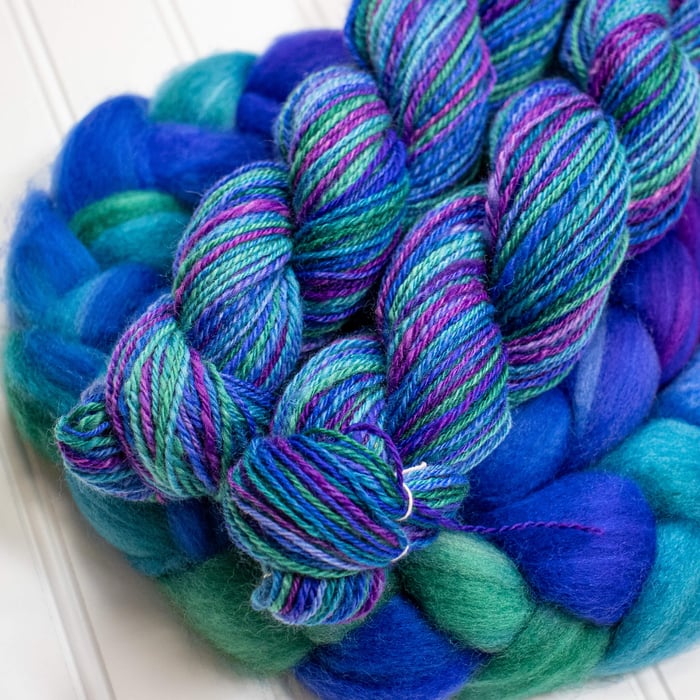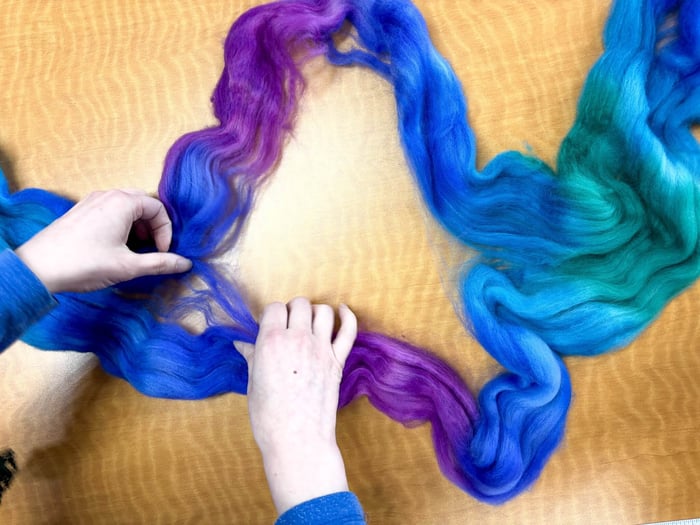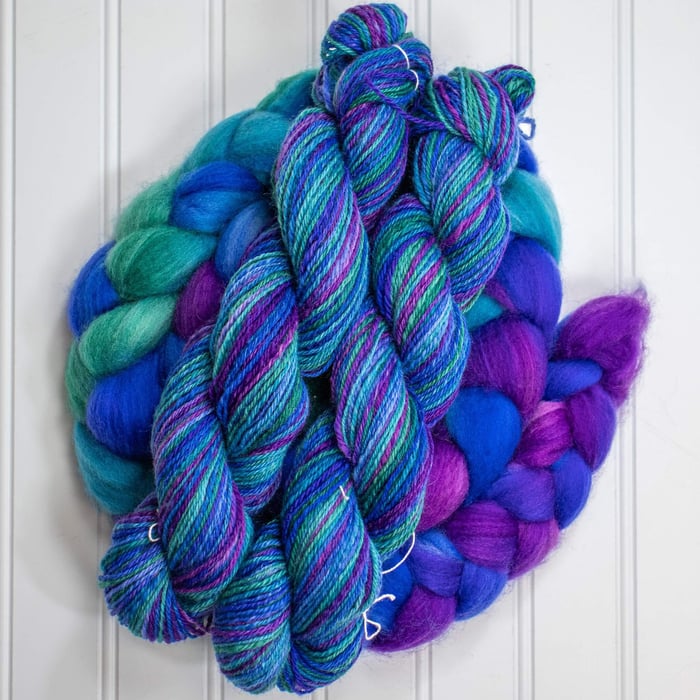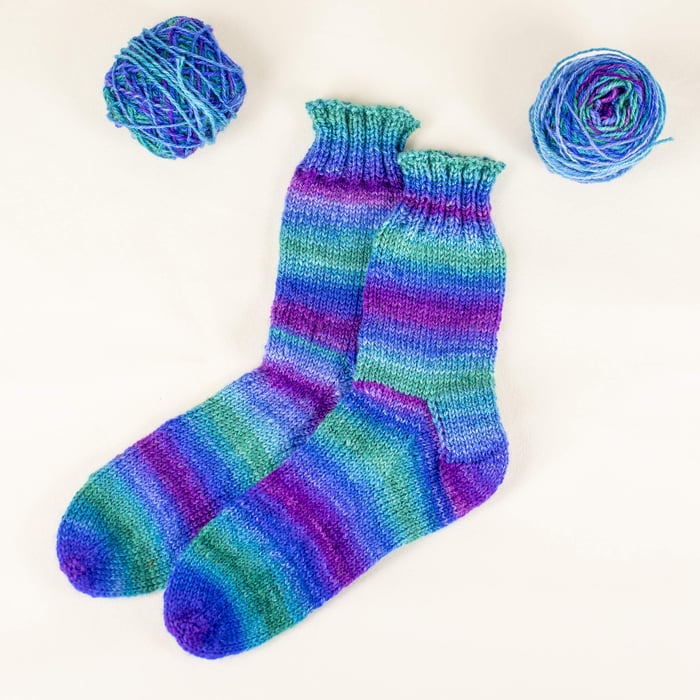Our Blog


Greenwood Fiberworks Sock Roving Review
I’ve been so excited to try this new superwash BFL/Nylon sock roving ever since I heard it was coming! We’ve had a lot of people ask for a sock roving, and all the colors of this blend from Greenwood Fiberworks are so lovely it was hard to pick which one to spin first!
I’ve been spinning for over ten years and knitting socks for at least that long, but somehow I had never spun a fiber blended specifically for socks before. However, I’ve spun many (many many) braids of Greenwood fiber on a variety of other bases so I knew I would not be disappointed.
There are at least as many ways to spin hand painted fiber as there are people who spin hand painted fiber, and none of them are wrong as long as they produce the yarn the spinner is aiming for. I don’t claim this is the only way, or even necessarily the best way to spin sock yarn, it is simply the way that worked for me to create this particular yarn.
I mostly wear my hand-knit socks as house socks to insulate my feet from the cold hardwood floors in my house, so I like my sock yarn a little closer to light sport weight than the usual fingering weight. I love experimenting with the different ways you can play with color in a fiber braid, but for this project I wanted the colors in the finished yarn to look exactly like they did in the fiber braid, bands of color without any barber poling of the plies, and I wanted the stripes on each sock to roughly match.
For me, that means chain-plying is the way to go. I know it’s conventional wisdom that chain-plied yarns are not durable enough for socks, but I have not noticed a difference in durability between my chain-plied yarns and traditional 3-ply yarns. If you prefer not to chain-ply for socks, these colors would also look amazing as a 3-ply fractal or as a marled 2x2 cabled yarn! (I may already be planning to spin for another pair…)
The first thing I do with any fiber braid is lay out the whole braid on a table and carefully unfold the fiber until it lays flat. Commercially prepared top is not generally a solid round “cord” of fiber, but a flat layer of aligned fibers that has then been folded or bunched up into a round shape. Gently opening it back into one flat layer makes it much easier for me to divide the braid evenly, and also makes it easier to spin “across the top” of the fiber to keep the colors from mixing as I draft.

The fiber was excellently processed and it wasn’t hard at all to find all the folds and open them up. Superwash fiber is more slippery than regular wool, so I did have to make sure I didn’t accidentally pull the fiber apart.
With the fiber nicely opened up flat, I divided the whole braid in half vertically, then starting from the same end I loosely chained each half to keep the fibers neat.
Spinning and then chain-plying each half separately starting from the same end gives me two equal 2oz skeins of yarn, one for each sock, with roughly matching color repeats. Once I started spinning, I almost immediately realized that splitting the braid only once would make each color section much too long for a small diameter project like a sock, even allowing for the way chain-plying shortens color repeats, so I un-chained both halves and divided each in half again for four total strips.
Not all braids work out this way, but this particular braid happened to begin and end at the same point in the color repeat, so I was able to simply join the second quarter-section onto the end of the first for each bobbin without having to do any extra finagaling to avoid disrupting the color sequence in the middle. If I’d been very careful, I might have been able to divide the quarter-sections in half again for eight total strips of roving and very narrow stripes, but since this is superwash fiber I was concerned if I stripped it down too much the fiber might just drift apart.
One thing I really appreciate about fiber from Greenwood Fiberworks (besides the lovely colors) is that once it’s unbraided I’ve always found it ready to spin without having to fluff, steam, or predraft the fibers to loosen them up. Whether I’m splitting the fiber into strips to play with the color arrangement or just unchaining it and spinning it end to end as it is, there’s no extra prep required to get spinning!
This braid was no exception, it drafted smoothly and I didn’t need to mess around with the fiber at all beyond dividing it for color management, and was easy to spin to exactly the weight I was aiming for. Once I was actually spinning the fiber, it didn’t feel as slippery as other superwash wools I’ve spun, though definitely still more slick than regular wool. I expected the nylon to make the fiber more slippery, but perhaps it gave a little extra grippiness to the fiber? I had avoided sock yarn blends in the past because I worried the nylon wouldn’t draft well with the wool or would give the fiber a plasticky texture, but the nylon was virtually unnoticeable and did not give any unpleasant feel to the fiber. I had the whole braid spun up in what felt like no time at all.
Here’s my finished yarn, ready to be knit up into cozy handspun socks!

I knit my socks at a firm gauge for added sturdiness. The yarn is very soft and easy to work with, and the socks don’t feel stiff even at a tight gauge. I knit them with a 6” cuff and only used a little over half the yarn; I could have easily gotten two pairs of shorter socks from the yardage I had. I’m very happy with these socks and will definitely be spinning more of this fiber in the future!

Greenwood Hand Dyed Superwash BFL/Nylon Sock Roving

$29.99
Greenwood Hand Dyed Superwash BFL Sock Roving This custom superwash BFL & nylon sock roving blend from Greenwood Fiberworks is perfect for socks, or any...… read more



